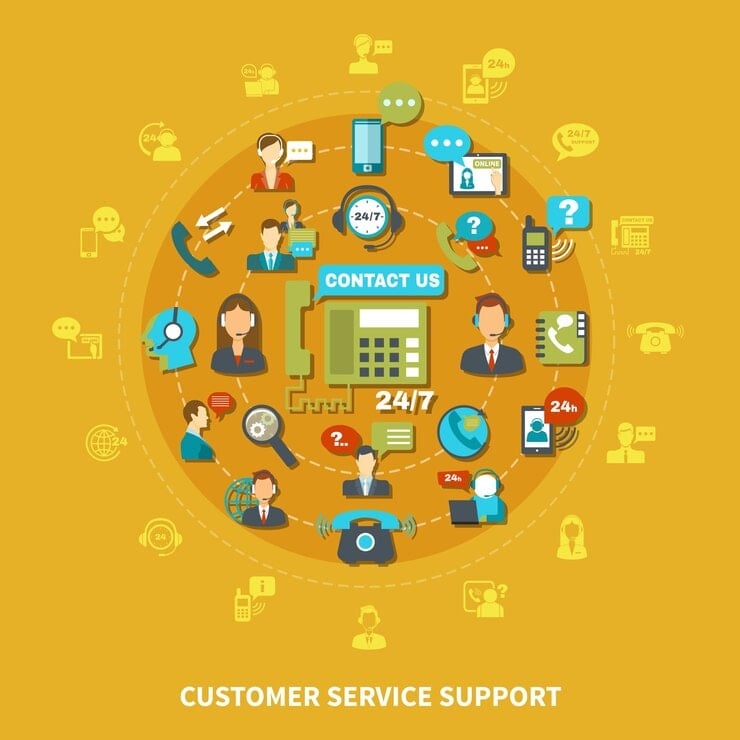You’re doing it wrong. All of it. Your fancy AI chatbots, your cutting-edge analytics platforms – they’re not the key to customer satisfaction. Not even close.
The truth about self-service is what? It’s the basics that make or break your customer service. And I’m willing to bet you’re overlooking them.
In 2024, a staggering 96% of customers say they’ll leave a company after a bad customer service platform or experience. Yet businesses keep chasing the next big tech solution, ignoring the fundamental customer service tools that move the needle.
I’ve seen it firsthand. A small e-commerce company was hemorrhaging customers despite investing in the latest CRM customer service software. Their problem? They couldn’t handle simple email inquiries efficiently. Basic customer service tools, implemented correctly, turned their entire operation around.
Here’s the kicker: these fundamental customer service tools aren’t just “nice to have.” They’re the bedrock of customer loyalty. Get them right, and you’ll see satisfaction scores soar. Get them wrong, and no amount of AI wizardry will save you.
Do you know what these essential customer service tools are? I challenge you to read on. Because what I’m about to share goes against the grain of modern customer service wisdom. It might make you uncomfortable. It might even make you angry.
But it will transform how you approach customer satisfaction.
Are you ready to unlearn everything you think you know about customer service tools? To discover the simple, often overlooked solutions that can catapult your business ahead of the competition?
Lower your delivery costs by 23%
How we reduce costs:
- No delivery vehicle expenses
- Optimized local routes
- Pay-per-delivery model
- Average 23% delivery cost reduction
Step 1: Selecting Essential Customer Service Software
Finding the right customer service software is a must for any company. The right customer service tools and help desk customer service software can improve response times, enhance satisfaction, and boost efficiency. Let’s break down how to select these customer service tools.
Identify Your Needs
Understanding your specific needs is the first step. You can start by looking at your current challenges: What bottlenecks do you face? Are you missing certain features that could improve your customer support tool? For example, if slow response times are an issue, features like automated ticket routing might be crucial. Many businesses are also turning to AI solutions to handle routine inquiries, freeing up human agents for more complex tasks and ensuring customers receive immediate responses. Since emerging AI agents are poised to revolutionize enterprise efficiency, decision-making, and competitiveness, Identifying these needs helps you find customer service tools that align perfectly with your goals.
Research Reliable Customer Support Software
Once you’ve identified what you need, it’s time to look for software options. In our testing, some of the most popular customer service software includes Zendesk, Freshdesk, and Salesforce Service Cloud. These customer service software platforms offer robust feature sets and generally get positive reviews. The chosen customer service software must integrate well with your existing systems. Compatibility with systems like your CRM, internal communication, tools, or ticketing system is not just an added plus, it’s a necessity.
Test and Compare Customer Service Software Options
Before committing, try out different customer service software through free trials. This hands-on experience with customer service software like Zendesk or Freshdesk helps assess functionality and ease of use. During testing, note factors like user interface, customer support options, and analytics capabilities.
Here’s a simple table to help evaluate key features:
Zendesk offers extensive automation and integration options, making it ideal for handling high volumes of customer interactions efficiently. Freshdesk, on the other hand, stands out with its user-friendly interface and customer satisfaction scores.
Zendesk is our winner in this comparison. This help desk software delivers a comprehensive set of features that cater to a wider range of business needs. As Damon Richard stated, “Your customer doesn’t care how much you know until they know how much you care.” Choosing the right customer service software ensures you show that care effectively by being responsive and reliable for your clients.
Step 2: Implementing Fundamental Customer Support Tools for Enhancing Customer Experience
-
Efficient training boosts customer service tool adoption and user confidence.
-
Streamlining tasks saves time and improves service quality for customer support.
-
Continuous monitoring ensures tools deliver expected benefits.
Train Your Customer Service Teams
Effective training ensures your customer service team is equipped to handle new customer service tools. Begin by providing a comprehensive introduction to the customer support tools. You should explain their features, benefits, and how they fit within daily tasks. It is better to create detailed training materials that include step-by-step guides and video tutorials. Encourage questions to address any uncertainties.
Regular refreshers are vital. Schedule sessions periodically to reinforce knowledge and introduce updates. This not only keeps skills sharp but also maintains high team morale. Studies suggest that teams who engage in regular training show a 20% increase in productivity. Consider using peer training setups to build a collaborative environment.
Streamline Processes
Streamlining processes through automation can drastically enhance efficiency. Identify repetitive tasks that technology can handle. For call customer support teams, for instance, use automated responses for common queries. You can set rules for ticket routing to ensure customer inquiries reach the right agents swiftly.
Establish clear workflows that reflect customer service tool capabilities. Align these with team roles to avoid confusion. A well-structured workflow enhances team coordination and reduces the time taken to resolve customer queries, by up to 40%. This makes for a smoother, more efficient customer service operation. Automation should not replace the human touch but complement it, making workloads manageable.
Monitor Customer Service Tool Effectiveness
Regularly collect feedback from your customer service team to gauge customer service tool effectiveness. Direct insights from users can highlight areas that need adjustment, from user interface hurdles to integration needs. Encourage honest input in team meetings, community forums, or through anonymous surveys. An open feedback culture leads to continuous improvement.
It is better to use built-in reporting features of the tools to monitor their impact. Track key metrics like response time, resolution rate, and customer satisfaction scores. These data points offer a clear picture of how tools are performing. Adjust approaches based on findings, ensuring the customer support tools continue to align with service goals.
Step 3: Integrating Must-Have Customer Satisfaction Tools
-
Tools for customer feedback are crucial. They help understand what customers feel.
-
CRM software keeps everything organized and personalizes the customer support experience.
-
Combining different communication channels in one customer service tool boosts response speed.
Choose the Right Customer Service Tool with Feedback Features
Understanding customer opinions helps you grow. Collecting this data is a vital step in improving customer satisfaction.
Implement Surveys and Feedback Forms
You can start by adopting simple yet effective tools like surveys and feedback forms. These customer support tools enable you to gather insights directly from customers. You can use tools like SurveyMonkey or Google Forms to create and distribute surveys. These platforms offer templates that make it easy to design surveys tailored to your customer requests and specific needs. Set the surveys to trigger after customer interactions, such as after a purchase or service call.
Analyze Feedback Regularly for Customer Support
Once feedback is collected, analyze it consistently. It is best to set a specific schedule, like weekly or bi-weekly, to review the feedback. You can prefer to use tools like Excel or specialized software like Qualtrics to sort and interpret this data. Align this analysis with customer service goals to spot trends and pain points. These insights help prioritize what issues to tackle first.
Utilize CRM Software
CRM software acts like a hub for all customer data. It’s crucial for customer relationship management and personalized customer interactions.
Ensure Customer Data is Easily Accessible
You should select CRM systems that store data securely yet make it easy for the customer support team to access. Salesforce and HubSpot are popular because they centralize customer information. They offer dashboards that provide quick insights into customer history. You should train your customer relationship management team to use these dashboards effectively. This knowledge enables staff to solve problems swiftly by understanding the customer’s past issues and preferences.
Offer Personalized Experiences Through Data Insights for Customer Support
Utilize CRM data to personalize customer interactions. For instance, knowing a customer’s buying history allows your team to offer follow-up suggestions or special promotions. Segmentation features in most CRM tools help categorize customers based on their interactions and preferences. You can use these insights to craft marketing messages or service offers that align with customer needs. This approach fosters loyalty and can improve customer satisfaction scores.
Enhance Communication Channels
Being available on multiple platforms makes it easier for customers to reach you. It also speeds up response times to customer inquiries.
Use Tools Supporting Multi-Channel Communication
Tools like Zendesk or Freshdesk enable you to handle communications from different platforms—email, live chat, social media, and phone calls—all in one place. You can set up these customer support tools to ensure each platform receives appropriate customer support. Train your customer support team to switch between channels seamlessly. Encourage them to use a unified interface to manage interactions effectively.
Maintain Quick Response Times
Quick responses are key to customer satisfaction. Automate initial acknowledgments to reassure customers their queries are being addressed. Set performance metrics for response times and monitor them using the reporting features in your communication tools. Set a benchmark, such as responding to customer messages within one hour, to maintain customer expectations. Regularly assess this data to identify areas for improvement. Assigning dedicated staff to each channel ensures no message gets overlooked.
Empowering Customer Service with Basic Customer Support Tools
Customer service isn’t about flashy tech—it’s about understanding and meeting needs. The basic tools we’ve explored are your gateway to exceptional customer service teams. They simplify processes, enhance communication, and provide vital insights. But remember, customer service tool options are only as good as the people using them. Your team, armed with these resources and proper training, becomes the true driver of customer satisfaction. Understanding your **Customer Satisfaction Score** is essential for measuring the effectiveness of your service efforts. It’s a metric that can guide your improvements and drive customer loyalty. To delve deeper into how to measure this crucial metric and its impact on your business, check out this informative article on how to evaluate your Customer Satisfaction Score.
You shouldn’t underestimate the power of simplicity. Sometimes, a well-implemented feedback system or a responsive CRM can make all the difference. As you integrate these customer support tools, stay focused on your ultimate goal: creating experiences that keep customers coming back. For deeper insights into effective practices that enhance customer service, check out this comprehensive guide on achieving excellence in customer service. Implementing proven strategies can facilitate your transition towards customer service success.
To truly measure the impact of your efforts, it’s essential to track key performance indicators that reflect customer satisfaction and service efficiency. Understanding these critical customer service metrics allows businesses to identify areas for improvement and tailor their strategies accordingly. Whether it’s average resolution time, first contact resolution, or customer effort score, focusing on the right data helps ensure your customer service tools deliver meaningful results.
Additionally, it’s crucial to learn from past experiences to improve future interactions. Many companies unknowingly repeat customer service mistakes that can harm their reputation. Understanding these common pitfalls can help you avoid them. For insight into what not to do, this important resource on common customer service mistakes may provide guidance for your team.
Another valuable resource to consider is learning from the successes of others. There are numerous examples of good customer service that highlight effective strategies and approaches. By studying these examples, you can gain insights into best practices that may inspire your own customer service initiatives. For a deeper dive into some outstanding instances, take a look at these great examples of customer service that showcase what truly great service looks like.
The path to outstanding customer service is ongoing. Keep learning, adapting, and most importantly, listening to your customers. They’re your best teachers. With the right tools and mindset, you’re not just solving problems—you’re building relationships. And in business, relationships are everything.
Start small, think big, and watch as your customer satisfaction soars. Your journey to service excellence begins now. Are you ready to take the first step? For those seeking to delve deeper into the nuances of customer service, exploring proven practices can provide valuable insights. These practices emphasize the importance of fundamental strategies that enhance customer experiences. To better understand how to achieve customer service excellence, check out this comprehensive guide on customer service effectiveness.














